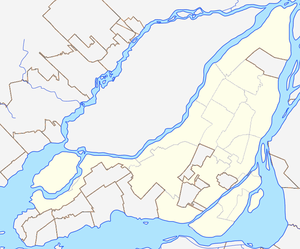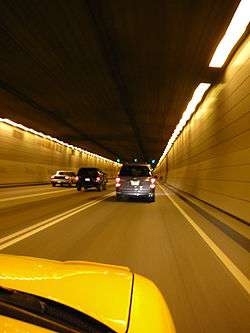Louis-Hippolyte Lafontaine Bridge–Tunnel
|
Montreal entrance to tunnel, 2009 | |
| Overview | |
|---|---|
| Location | Montreal, Quebec, Canada |
| Route | Autoroute 25 |
| Crosses | St. Lawrence River |
| Operation | |
| Opened | March 11, 1967 |
| Traffic | 130,000[1] |
| Character | Limited access highway |
| Technical | |
| Length |
1,391 m (4,563.6 ft) (tunnel section) 409 m (1,341.9 ft) (causeway section) |
| No. of lanes | 6 |
| Tunnel clearance | 4.4 m (14 ft 5 1⁄4 in) |
| Width | 37 m (121.4 ft) |
 Louis-Hippolyte Lafontaine Bridge–Tunnel (Montreal) | |
The Louis-Hippolyte Lafontaine Bridge–Tunnel (French: Pont-Tunnel Louis-Hippolyte-La Fontaine) is a Canadian highway bridge–tunnel running over and beneath the Saint Lawrence River. It connects the Montreal borough of Mercier–Hochelaga-Maisonneuve with the south shore of the river at Longueuil, Quebec.
Named after Lower Canada political reformer Louis-Hippolyte Lafontaine, the Lafontaine Tunnel is an immersed tube structure, measuring 1,391 m (4,563.6 ft) long. It carries the Autoroute 25 expressway and passes beneath the main shipping channel in the Saint Lawrence River immediately downstream from the Saint Lawrence Seaway. It surfaces on Île Charron (Îles de Boucherville at entrance/exit #1 of Autoroute 25), then continues by bridge to Longueuil.
The bridge-tunnel sees about 130,000 daily crossings, of which over 15,000 are trucks.[1] Its construction began in 1963 and it opened on March 11, 1967.[2][3]
Construction history
In 1960, the construction of the Trans-Canada Highway (TCH) through Quebec from the Ontario border to Rivière-du-Loup was announced. In Montreal, to avoid having to build a huge bridge that would have disfigured the city and destroyed a neighbourhood, the engineers opted for the construction of a tunnel located under the Saint Lawrence River, and dug a trench under the river bed and buried the tunnel sections 4.6 metres (15 ft) to 6.1 metres (20 ft) under the river bed. The Longue-Pointe church had to be demolished to make way for the tunnel, and 300 families were expropriated from the village in 1964.[4] The construction was completed in March 1967, just before the opening of Expo 67. Construction cost $75 million.[5]
Specifications

Each of the seven tunnel sections weighs 32,000 t (31,000 long tons; 35,000 short tons),[3] is 110 metres (360 ft) long, 37 metres (121 ft) wide and rises to a height of 8 metres (26 ft). In total, the bridge–tunnel is 1.8 kilometres (1.1 mi) long. The tunnel was built with sections prefabricated in dry dock and then sunk in the river,[6] 24 metres (79 ft) below the surface of the water. It is one of the largest prestressed concrete structures in the world, and is the longest bridge-tunnel in Canada.[2]
See also
References
- 1 2 Bruno Bisson (2017-10-20). "Tunnel L.-H.-La Fontaine: quatre ans de travaux dès novembre 2019". La Presse (in French). Retrieved 2017-12-20.
- 1 2 "Louis-Hippolyte-Lafontaine, the longest bridge-tunnel in Canada, turns 50". Montreal Gazette. 2017-03-11. Retrieved 2017-12-20.
- 1 2 "Il y a 50 ans, le pont-tunnel était inauguré". Métro (in French). Retrieved 2017-12-20.
- ↑ "Un village sacrifié pour le pont-tunnel". Métro (in French). Retrieved 2017-12-20.
- ↑ "At 50, the Louis-Hippolyte-La Fontaine bridge-tunnel still a world-class wonder". CBC News. Retrieved 2017-12-20.
- ↑ Ministère des Transports (2014-03-28). "Construction du Pont-tunnel Louis-Hippolyte-La Fontaine" (in French). Retrieved 2017-12-21.
External links
- Louis-Hippolyte Bridge–Tunnel (A-25) at Steve Anderson's montrealroads.com
- Louis-Hippolyte Lafontaine Tunnel at Structurae
Coordinates: 45°34′46″N 73°28′46″W / 45.57944°N 73.47944°W